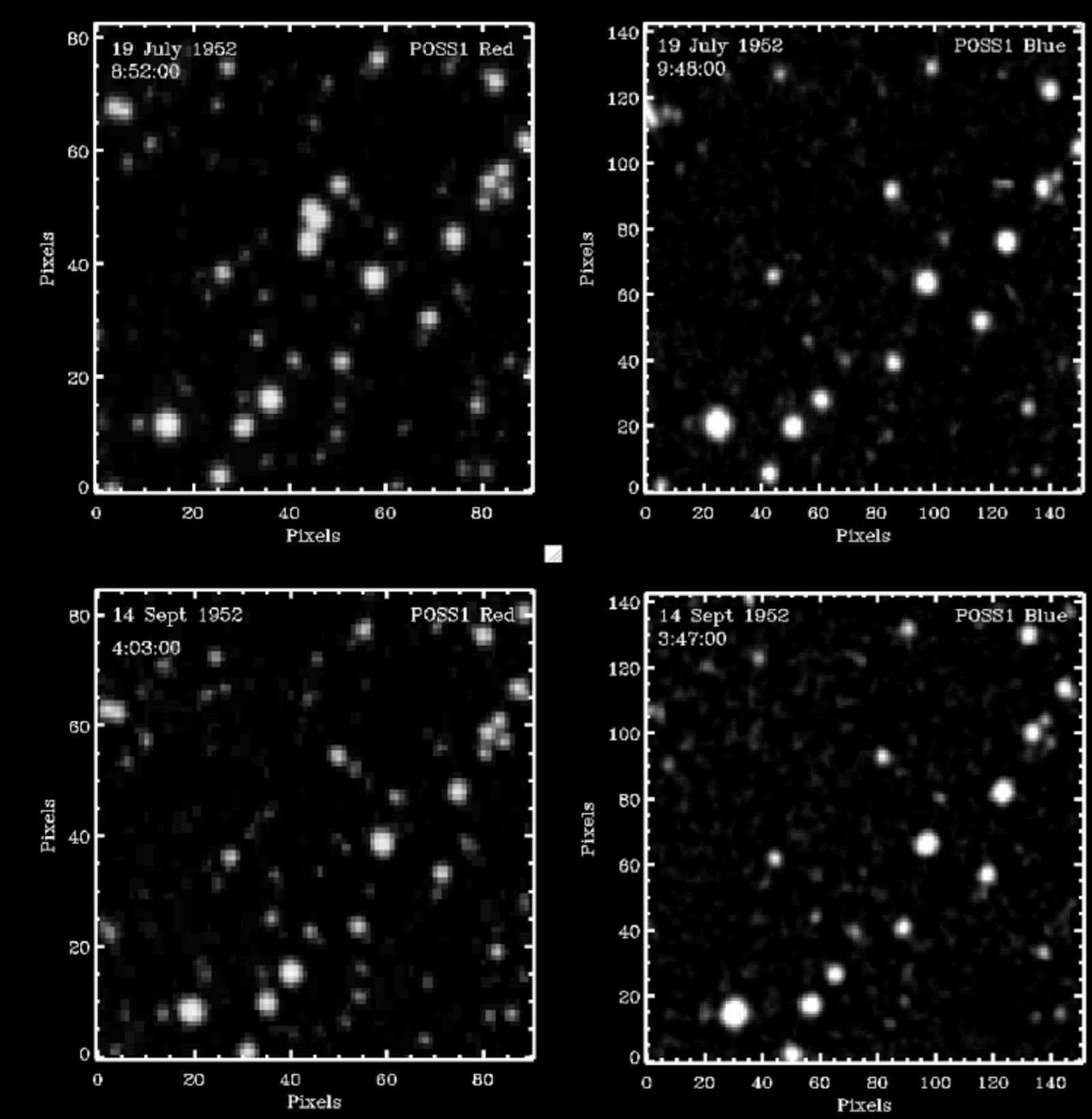🛸 How can these strange lights in the sky, captured before the space age, be explained?
Published by Cédric,
Article author: Cédric DEPOND
Source: Scientific Reports
Other Languages: FR, DE, ES, PT
Article author: Cédric DEPOND
Source: Scientific Reports
Other Languages: FR, DE, ES, PT
Follow us on Google News (click on ☆)
These objects, which appeared and disappeared within minutes on the plates from the Palomar Mountain Observatory, constitute a persistent enigma for the scientific community. Their very existence challenges our understanding of the circumterrestrial environment at a time considered pristine from any human orbital pollution.

Four exposures of the 3 × 3 arcminute sky region centered on the triple transient identified in July 1952.
Top left: POSS I red image from July 19, 1952 at 08:52 (UT) showing the triple transient just above center.
Top right: POSS I blue image of the same region, with a 10-minute exposure time, taken immediately after, showing no trace of the triple transient.
Bottom left and right: POSS I red (left) and blue (right) images taken two months later (September 14, 1952), showing that the transient has disappeared.
The VASCO project (Vanishing and Appearing Sources during a Century of Observations) has taken on the systematic mission of analyzing these celestial anomalies. By scrutinizing thousands of historical photographs, researchers have cataloged more than 100,000 of these transient phenomena. The point-like and stellar nature of these sources, their absence in earlier and later photographs, and their detection on reliable period equipment rule out the hypothesis of simple emulsion defects or dust.
This methodological rigor gives particular weight to these old observations, offering a unique field of investigation for contemporary astronomy.
An investigation into photographic anomalies
The meticulous analysis of the Palomar Observatory Sky Survey plates required advanced comparison techniques with modern stellar catalogs like Gaia. Each fleeting bright point was scrupulously verified to ensure it did not correspond to a known variable star, an asteroid, or any processing artifact. The brevity of their appearance, always less than the 50-minute exposure duration, indicates an intrinsically brief phenomenon and not a persistent source. This characteristic is at the heart of the mystery surrounding them.
The quality of the photographic plates and the reproducibility of the development methods used at the Palomar Mountain Observatory were carefully reassessed. Researchers ruled out that recurring technical problems, such as internal reflections in the telescope optics or emulsion sensitization defects, could generate such sharp and localized signals. The random distribution of these fleeting appearances across the sky, unrelated to the optical structure of the instrument, reinforces the idea that these are real phenomena captured by the lens.
The orbital environment of the era is a key element of the investigation. The analyzed period, spanning from 1949 to 1957, predates the launch of Sputnik 1. It is therefore, in theory, free of any debris or artificial satellites. This historical constraint makes the simplest explanation – reflections from objects in orbit – highly improbable, forcing consideration of more exotic origins or natural phenomena not yet cataloged for these objects located outside the atmosphere.
Intriguing correlations with human activity
It was only after establishing the reality of these phenomena that researchers explored temporal correlations with other events. Their statistical analysis revealed a significant increase in the frequency of these glows within 24 hours following atmospheric nuclear tests. Although this association does not demonstrate a cause-and-effect relationship, its repetition over several years deserves, according to the study's authors, particular attention and further investigation.
Simultaneously, another correlation, more tenuous but statistically notable, was observed with contemporary reports of unidentified aerospace phenomena. On days when such testimonies were reported, the number of fleeting luminous manifestations detected on the photographic plates increased slightly. This double correlation, with nuclear events and visual observations, complicates the interpretation without providing a definitive key.
Scientists remain extremely cautious in their conclusions. They emphasize that these correlations could be coincidental or point towards a common causal factor not yet identified, perhaps of geophysical or atmospheric origin. The exact nature of these light sources and the reason for their apparent link with specific human activities remain an open question, which will require the study of other historical archives or the implementation of new dedicated observation campaigns.